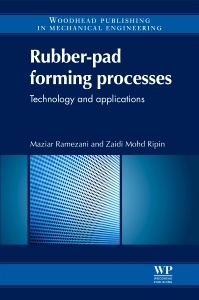Description
Rubber-Pad Forming Processes
Technology and Applications
Language: English
Subject for Rubber-Pad Forming Processes:
310 p. · 15.5x23.2 cm · Paperback
Description
/li>Contents
/li>Biography
/li>Comment
/li>
List of figures and table
Preface
About the authors
Chapter 1: Introduction to sheet metal forming processes
Abstract:
1.1 Introduction
1.2 Sheet metal forming processes
1.3 Flexible-die forming
Chapter 2: Principles of rubber-pad forming
Abstract:
2.1 Introduction
2.2 Advantages and disadvantages of rubber-pad forming process
2.3 Guerin process
2.4 Verson-Wheelon process
2.5 Marform process
2.6 Verson hydroform process
2.7 SAAB rubber-diaphragm process
2.8 Maslennikov’s process
2.9 Tube bulging
2.10 Demarest process
Chapter 3: Characteristics of elastomer materials
Abstract:
3.1 Introduction
3.2 Elastomer types
3.3 Compounding
3.4 Typical elastomers used in rubber-pad forming processes
3.5 Mechanical properties of elastomers - linear elastic
3.6 Mechanical properties of elastomers – non-linear elastic
3.7 Hyperelastic models and elastomer mechanics
Chapter 4: Forming of shallow parts using rubber tools
Abstract:
4.1 Introduction
4.2 Guerin process
4.3 Free forming
4.4 Bending
4.5 Multi-point forming of sheet metals with rubber cushions
Chapter 5: Piercing of sheet metals using rubber punch
Abstract:
5.1 Introduction
5.2 Analysis of fracture load
5.3 Analysis of ram movement
5.4 Quality of the pierced specimen
Chapter 6: Deep drawing of sheet metals using the friction-actuated blank-holding technique
6.1 Introduction
6.2 Theoretical investigation of conventional deep drawing of a cylindrical cup from a circular disk
6.3 Friction-actuated blank holding technique
Chapter 7: Deep drawing using Verson hydroforming process
Abstract:
7.1 Introduction
7.2 Theoretical analysis of drawing stress
7.3 Analysis of process parameters
7.4 Deep drawing with elastomer membrane
Chapter 8: Deep drawing of sheet metals by Marform technique
Abstract:
8.1 Introduction
8.2 Theoretical analysis of the Marform process
8.3 Pressure distribution at different portions of rubber die
8.4 Results of analytical approach
8.5 Development of thickness strain
8.6 Forming a limit diagram
Chapter 9: Deep drawing of sheet metals by Maslennikov’s technique
Abstract:
9.1 Introduction
9.2 Theoretical analysis
9.3 Analysis of first stage drawing
9.4 Analysis of repeated drawing operations
9.5 Collar drawing
9.6 Redrawing with a rubber ring
Chapter 10: Tube bulging using rubber rods
Abstract:
10.1 Introduction
10.2 Tube end bulging
10.3 Bulging at the middle of a tube
10.4 T-branch forming
10.5 Theory of axisymmetric tube bulge forming
10.6 Other tube bulging processes
Chapter 11: Conclusions
Combined bibliography
Index
Dr Zaidi Mohd Ripin is Associate Professor and Dean of School of Mechanical and Aerospace Engineering, Universiti Sains Malaysia, Malaysia.
- The potential role of rubber as a flexible punch in metal working processes is to give insight to engineers about different parts that can be produced using this process
- The procedure of suitable die design for each process is presented in detail
- Full defect analysis is undertaken with a thorough report presented to optimize rubber-pad forming processes




